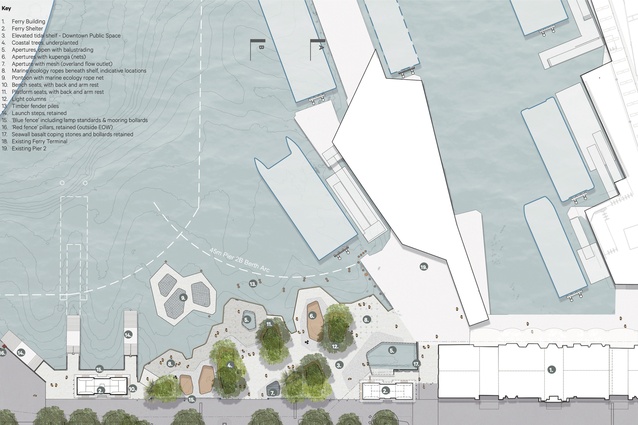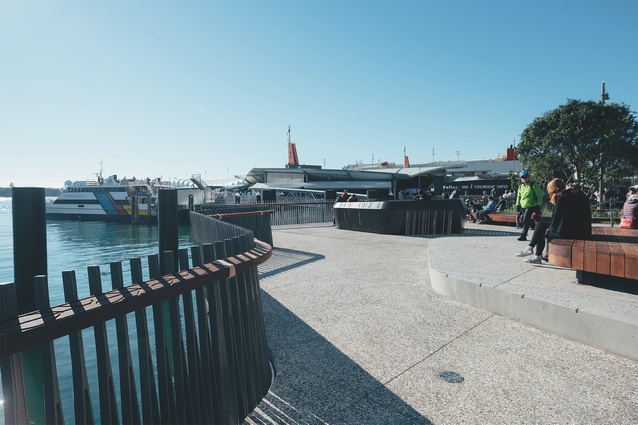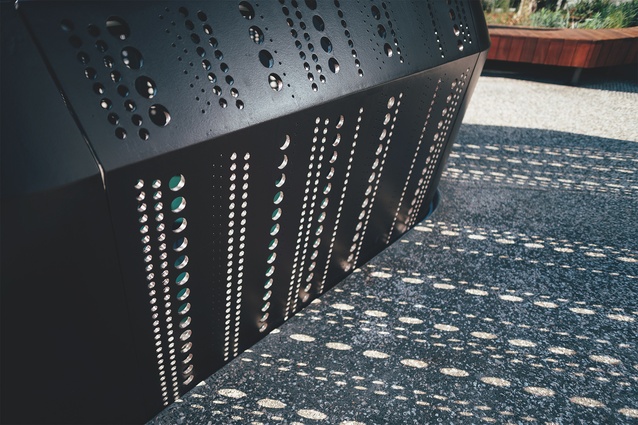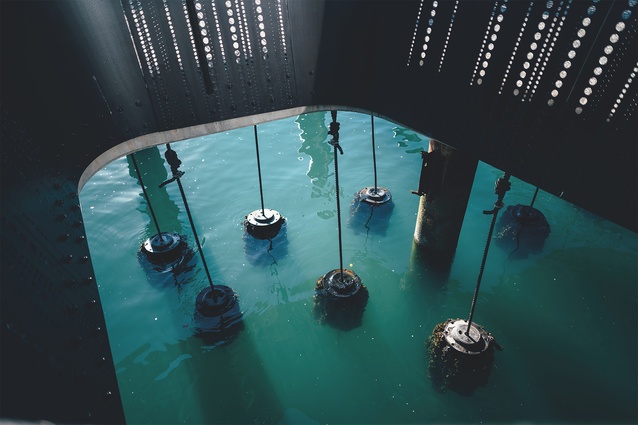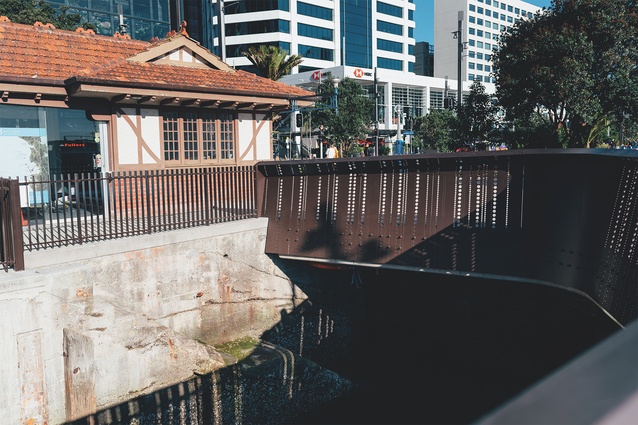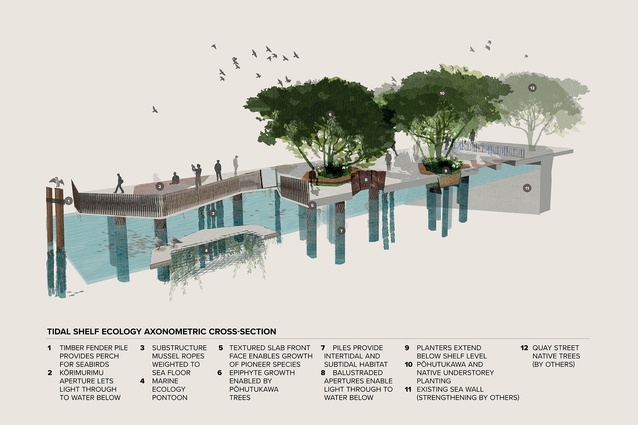The space between
Chris Barton explores Te Wānanga, the long-planned replacement public space for the former Queen Elizabeth II Square, and Te Ngau o Horotiu, the new Downtown Ferry Terminal. The Auckland Council and Auckland Transport projects, designed by Isthmus, in collaboration with 11 mana whenua iwi, bring a vibrant new interface to Te Waitematā’s waterline.
When the first of two kōrimurimu was revealed in July, Mayor Phil Goff encouraged Aucklanders to lie on the flax-like surface and “breathe in the sea air, look up to the sky and hear the movement of the tide below”. Not the first thing that comes to mind to do in Te Wānanga, Auckland’s new waterfront public plaza beside the Ferry Building between Princes and Queens Wharves. But people are standing and sitting on it. Kids seem to love its bounciness. And some are lying on it – a sleeping bag was spotted in it recently.
What if a whole lot of drunken people climbed into it and went a bit crazy late at night? “That is exactly what it is loaded for,” says Isthmus architect Sarah Bishop, pointing out there is a secondary system, a safety net, underneath. The mat is also strong: made of woven strands of military-grade, camouflage-green stropping used in haulage nets for heavy lifting.
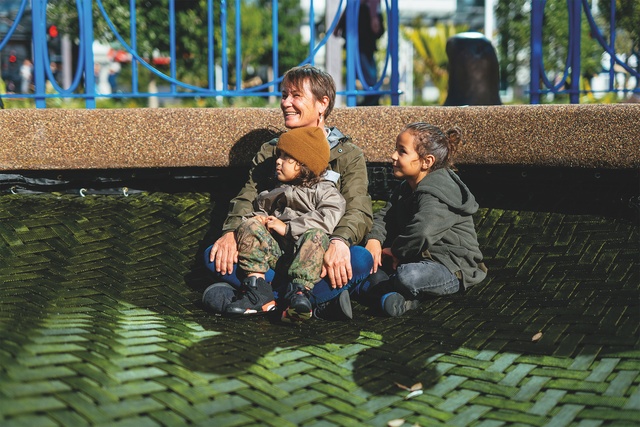
You have to admire the bravery, not to mention the innovation, of installing this interactive artwork in a public place. About the size of a big trampoline, the kōrimurimu is one of several large holes – Isthmus calls them apertures – cut into the 73m-wide, 600–950mm-deep concrete platform alongside the revamped two-lane, tree-lined Quay Street boulevard. Conceived as an intertidal shelf, it extends 36m over the Waitematā Harbour, hovering on 49 piles.
Getting into the kōrimurimu requires a 600mm step down and a leap of trust that’s worth the effort. Its name means to be covered in seaweed – rimurimu being a seaweed native to Te Waitematā. The work, by artist Tessa Harris (Ngai Tai ki Tāmaki) in co-design with Isthmus, using traditional Māori weaving cross-hatched like a basket, is a “visual ecological response” – a kind of memorial to a time when the downtown foreshore was covered in seaweed, a vital food source for many fish species now also in decline.
You might say the whole of the porous public space of Te Wānanga is a memorial. Its undulating, jagged edge, jutting into the harbour in sharp contrast to the straight line of the now-strengthened sea wall along the Quay Street edge, takes its organic shape from the historic natural shoreline of sandstone headlands, present in 1840, but now long gone through successive land reclamations. A trace of what was in pre-colonial times.
“Conceptually, we are trying to create an intertidal shelf,” says Isthmus principal David Irwin. “And, in that, we have ecologies for humans and for nature.” That includes massive transplanted pōhutukawa reintroduced as a “coastal forest grove” surrounded by other native planting, including rongoā (medicine) species and harakeke (flax), now flourishing in six huge steel planters slung to the underside of the shelf like giant limpets. The gardens are surrounded by bench seating in reddish-brown Tonka hardwood from South America. The tidal shelf concept is also expressed in the strip of shelly concrete following Te Wānanga’s harbour edge, giving a washed-up-on-a-beach effect.
The other apertures are framed by steel balustrades styled like giant kina shells and invitingly shaped to lean on and look down to the water. “The point is really to demonstrate that there is an ecology under here and that we should be looking after our water,” says Irwin.
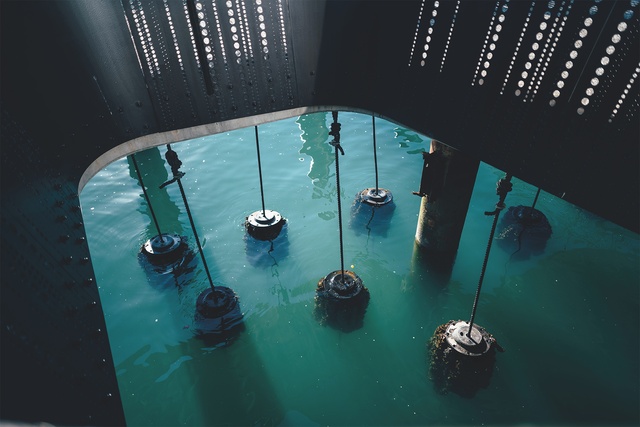
Here, Isthmus worked with Richelle Kahui-McConnell (Ngāti Maniapoto) and Jarrod Walker (Ngāpuhi) to anchor some 38 seeded kūtai (mussel) ropes with floats – as used in mussel farming – beneath the public deck. The aim is to support the re-establishment of the extensive kūtai beds that once covered the seabed of Te Waitematā while also filtering its grossly polluted water. Despite their remarkable filtering ability – each mussel capable of filtering between 150 and 200 litres of seawater a day – such are the pollutants here, these are sacrificial kūtai, not for eating, except by the fish who don’t know any better. As such, the kūtai act as perfect bio-indicators of the aquatic health in the inner harbour. You have to admire the ambition but it’s also hard to see how the seabed mud here, thick with decades of petroleum heavy metals and other stormwater run-off nasties, will ever be cleaned via filtering alone. One imagines more drastic intervention is needed.
A later stage of the Te Wānanga design integrates floating, open-aperture pontoons offshore from the public deck. Moving vertically with the rising and falling tide, the pontoons hold marine ecology ropes and nets for kelp beds to provide habitat for other marine species. It’s possible the pontoons may become a ‘floating research station’, containing scientific equipment measuring indicators of water quality and marine species health.
Leaning over the eastern balustrade aperture gives a view of the past – the 1920 stone stairway of Auckland’s historic ferry infrastructure alongside a portion of the now earthquake-strengthened Quay Street sea wall. Other heritage components that seem unnecessary clutter include the blue steel Auckland Harbour Fence, first erected in 1923 along Quay Street, and a 1915 memorial obelisk to harbour board staff serving in World War One. One can’t help thinking Te Wānanga might be better off without these colonial reassertions on the space. Surely the new access to the water’s edge means the jarring intrusion of the fence should now be gone and the war memorial obelisk perhaps better located at the museum. Let Te Wānanga, which weaves mātauranga Māori through its spaces and narratives, speak as a masterclass in delivering on Auckland Council’s Te Aranga Māori Design Principles. As seen, for example, in the timber handrails of the concertina steel balustrade that snakes around the harbour edge of Te Wānanga.

Here, Reuben Kirkwood (Ngai Tai ki Tāmaki) has carved a contemporary rendering of a Te Wairere motif symbolising the relationship between the land and the sea. The whakairo (carving) is complemented by Harris’ tightly laced natural fibre bindings or haumi – an expression of joining together.
In Isthmus descriptions of the space, much is made of how the design offers a new invitation to the water’s edge, the space between land and sea, city and harbour. “It will restore the edge as a place of respite and refuge: a knowledge basket for all who visit, and a breathing point for everyone and everything that filters through this busy place where the city meets the sea.” At times, the descriptions use spiritual metaphors: “Stitching together the land and the sea, the design brings to life Te hā o Te Tangaroa, the breath of Tangaroa the sea god: the natural rhythm and space between high and low tides…”.
In the face of all this, it’s disappointing the design does little to address climate change. You could say, in the massive amount of carbon emissions used in its concrete construction, it’s contributing to the crisis. Irwin says the choice of concrete was to ensure that Te Wānanga was robust enough to “survive in a big catastrophe event”. But if that is a flooded waterfront, whether by sea-level rise or extreme weather storm surge, then Te Wānanga will be a fitting island memorial to Auckland Council and Auckland Transport putting their heads in the sandstone.



